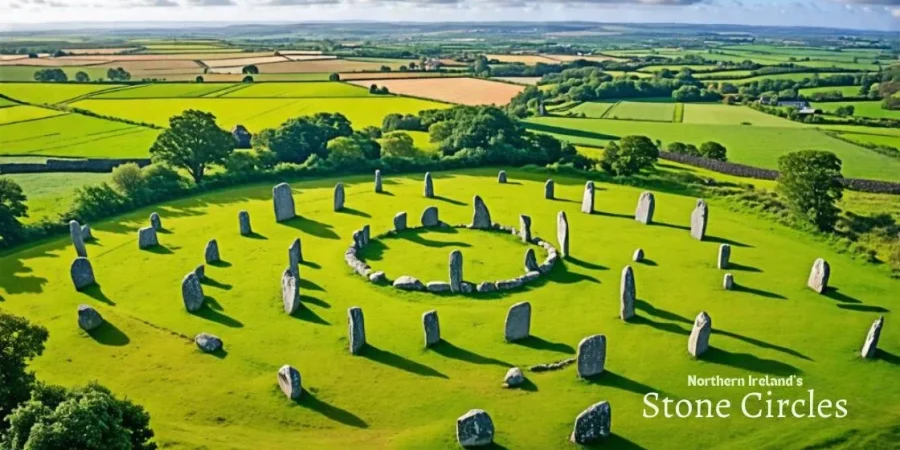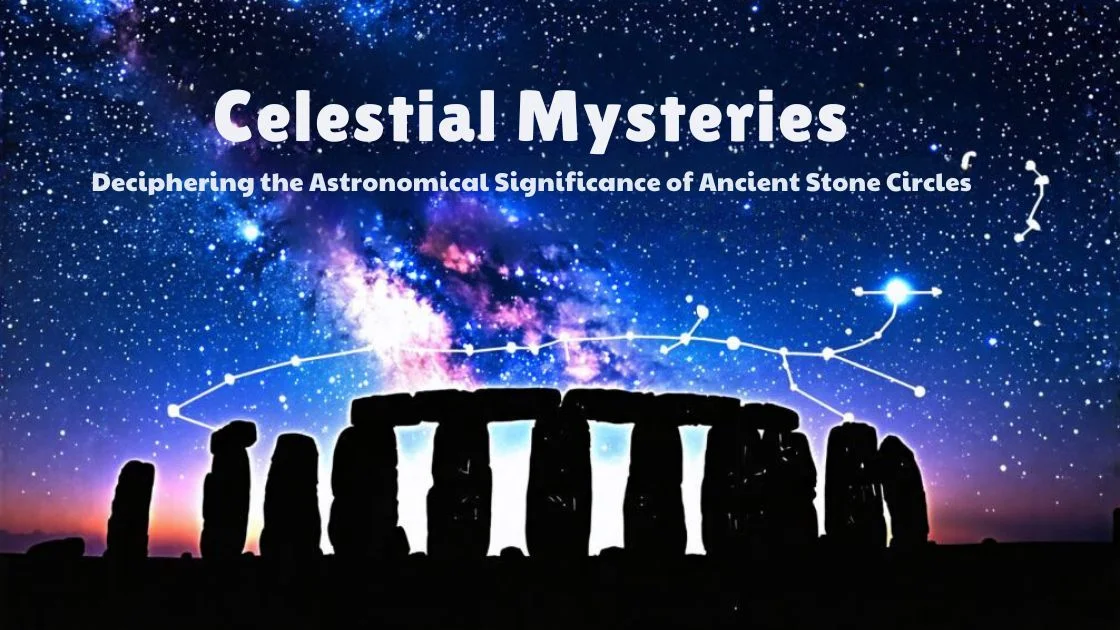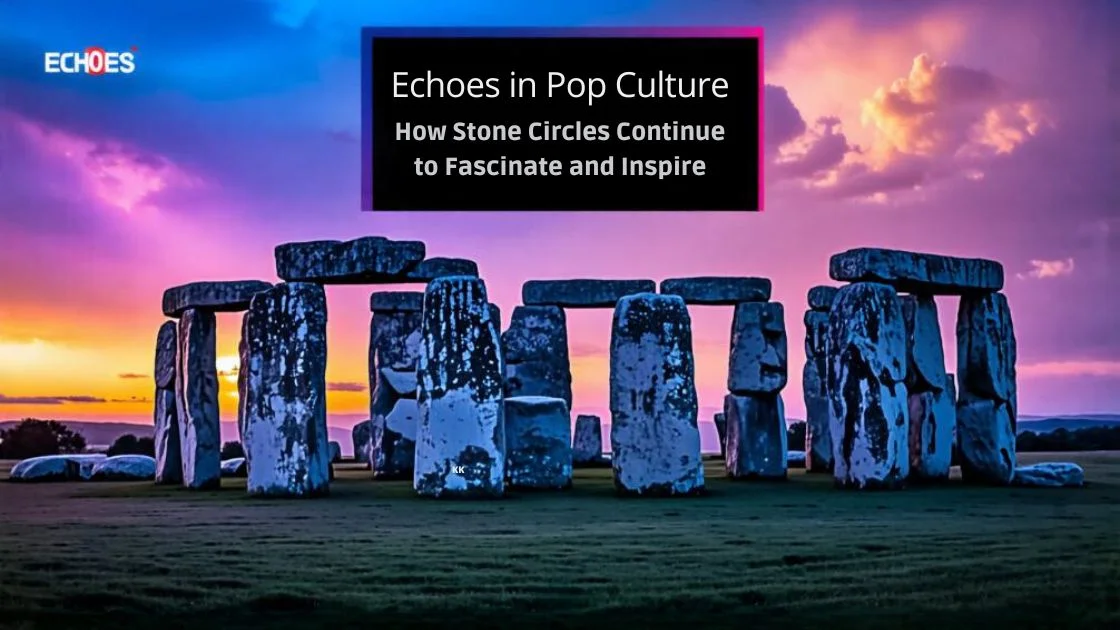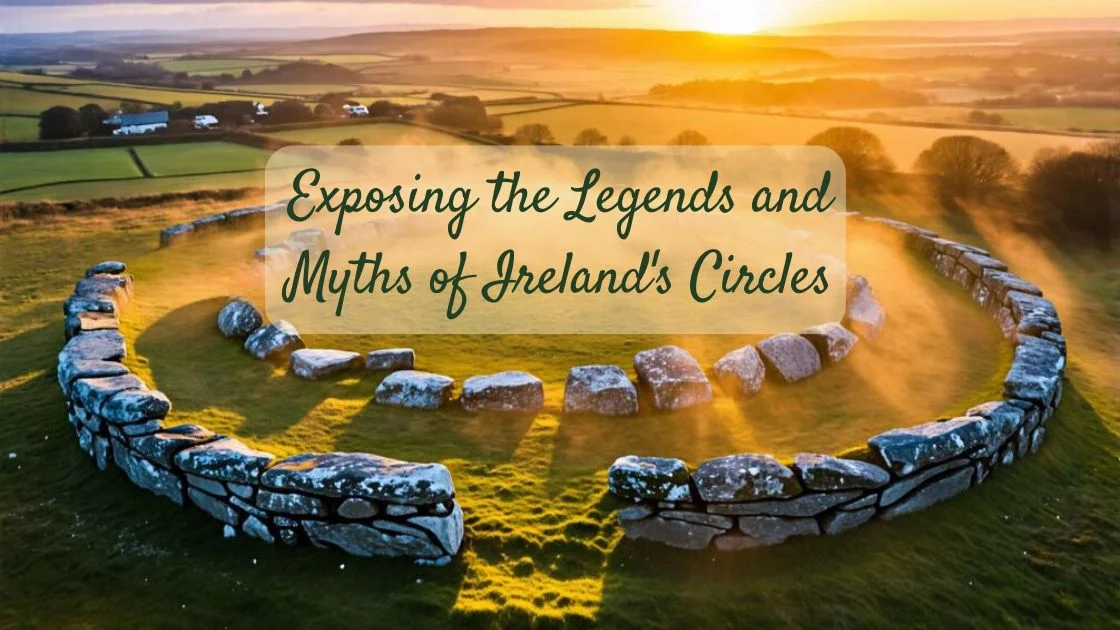You’re about to unravel the mysteries of Northern Ireland’s ancient stone circles. As you chart their locations and delve into their enigmatic past, you’ll not only appreciate their historical significance but also grasp their place in Irish identity.
From Ballynoe to Beaghmore, you’ll analyze these silent sentinels, understanding their role in a culture that cherishes freedom. This journey isn’t just about mapping stones; it’s about connecting with a heritage that resonates with autonomy and continuity.
Key Takeaways
- Stone circles in Northern Ireland have a rich historical significance and play a vital role in Irish identity and culture.
- Ballynoe, Drumskinny, and Beaghmore are key stone circle sites in Northern Ireland, each with their own unique origins and uses.
- Detailed information on each stone circle, including Ballynoe, Drumskinny, and Beaghmore, can be explored to understand their historical and archaeological significance.
- The stone circles have astronomical alignments, cultural impact, and symbolism, connecting them to Celtic mythology, pagan beliefs, and serving as symbols of Irish heritage and landscape.
Introduce the mystical allure and historical significance of Northern Ireland’s stone circles
As you explore the stone circles of Northern Ireland, you encounter the enigmatic Ballynoe, set within the picturesque County Down, which beckons a closer examination of its origins and uses.
The Drumskinny Stone Circle in County Fermanagh offers a unique layout that provides key insights into the region’s prehistoric practices.
Meanwhile, Beaghmore in County Tyrone presents a complex of circles and cairns, including the dense collection known as the Dragon’s Teeth, revealing multifaceted layers of historical and archaeological significance.
Briefly mention the three key sites: Ballynoe, Drumskinny, and Beaghmore
You’ll stumble upon the enigmatic beauty of Northern Ireland’s past as you explore the ancient stone circles of Ballynoe, Drumskinny, and Beaghmore. Each site whispers tales from millennia ago, beckoning a deeper understanding of their existence.
| Site | Location | Notable Features |
|---|---|---|
| Ballynoe | County Down | Large oval circle |
| Drumskinny | County Fermanagh | Aligned with cairn |
| Beaghmore | County Tyrone | Complex of circles |
| Ballynoe Stone Circle | Mystical allure | Historical relevance |
| Drumskinny Stone Circle | Archaeological insight | Cultural significance |
Analyzing these sites requires methodical examination of their layouts and functions. The Ballynoe stone circle, for instance, is a large oval structure with a distinct historical relevance, while the Drumskinny stone circle aligns intriguingly with a nearby cairn. Unpack their stories to appreciate the freedom these ancestors once had in crafting their legacy upon the land.
Ballynoe Stone Circle (County Down)
You’ll find the Ballynoe Stone Circle in County Down, a prehistoric site whose spatial arrangement and scale merit close examination. Its historical footprint, possibly from the late Neolithic to the early Bronze Age, offers a tangible connection to Ireland’s ancient past.
Assessing the archaeological evidence and mythological narratives surrounding Ballynoe provides insight into the cultural fabric of the time.
Overview and Location: Introduce Ballynoe Stone Circle, highlighting its location in County Down
Nestled in the rolling landscape of County Down, you’ll find the Ballynoe Stone Circle, a prehistoric marvel that anchors Northern Ireland’s rich ancient history. This county down stone circle isn’t just a cluster of rocks; it’s a testament to the sophisticated practices of ancient communities.
Consider these features to visualize the site:
- A sprawling oval of heavy stones, some standing, others fallen, arranged with purpose and precision.
- A meandering approach through verdant fields that gives way to the imposing presence of the Ballynoe Stone Circle.
- A surrounding landscape that whispers of millennia, with views that stretch beyond the circle, suggesting its significance in the wider context.
Your analysis of this site should be rooted in an appreciation for the freedom these stones have witnessed over centuries, unbound by modern constraints.
Historical Context and Characteristics: Discuss the age, structure, and unique features of the Ballynoe Stone Circle
As you step within the bounds of the Ballynoe Stone Circle, you’re stepping back into a world that predates written history by thousands of years, where the oval arrangement of megaliths reveals the complex social and ceremonial life of the Late Neolithic to the Early Bronze Age inhabitants.
Situated in County Down, the Ballynoe Stone Circle distinguishes itself through its size and elaborate form. Comprising over 50 standing stones, with some reaching two meters in height, it encloses an area that may have been ritually significant.
The circle’s precise age remains debated, but it’s generally attributed to a period spanning 3000 to 2000 BCE. Notably, the site uniquely features a long, stone-lined avenue leading to its center, hinting at processional activities linked to the surrounding landscape’s cosmology.
Cultural and Mythological Significance: Explore any mythological stories or cultural importance attached to Ballynoe
The Ballynoe Stone Circle, with its ancient arrangement of megaliths, isn’t just a marvel of prehistoric engineering but also a tapestry of local myths and cultural reverence that you’ll find entwined with the identity of County Down.
The circle’s mystique is rooted in Celtic Mythology. It’s said that druids performed sacred rituals here, connecting the circle to the spiritual realm.
Additionally, Irish Mythology adds another layer of intrigue to the Ballynoe Stone Circle. Legends speak of fairies and otherworldly beings, suggesting that the stones are a liminal space between worlds.
Furthermore, the alignment of the stone circle with celestial events hints at an ancient understanding of astronomy and the passage of time. This connection to Stone Circles offers insight into the knowledge and wisdom possessed by the people who created and revered these structures.
When analyzing Ballynoe within the framework of Celtic and Irish mythology, you’ll uncover layers of cultural significance. This exploration offers a glimpse into the freedoms and beliefs of the people who once revered these stones.
Archaeological Insights: Present any archaeological findings and their implications
Building on the cultural tapestry of Ballynoe Stone Circle’s mythology, you’ll find that its archaeological findings offer a tangible connection to its storied past.
As one of the archaeological stone circles ni, its structure provides crucial evidence of prehistoric monuments ni, articulating the sophistication of past societies.
Methodical excavations reveal a complex ceremonial site, with alignments possibly associated with astronomical events. These insights suggest a society deeply engaged with the cosmos, underscoring their desire for understanding and control within their environment.
The meticulous placement of stones, some sourced from distant locations, indicates a well-organized community with the means to mobilize resources for significant undertakings.
Ballynoe’s remnants, therefore, not only narrate tales of ancestral veneration but also reflect the freedom inherent in the human spirit to shape and understand the world.
Drumskinny Stone Circle (County Fermanagh)
You’ll find the Drumskinny Stone Circle nestled in the rural landscape of County Fermanagh, where its physical description and geographical setting lay the groundwork for understanding its place in history.
Unpacking the historical background of this site, you must consider the era of its construction and the cultural context of its use.
Additionally, examining any archaeological findings at Drumskinny can shed light on the circle’s significance and the local legends that have arisen around it.
Description and Setting: Describe the Drumskinny Stone Circle, emphasizing its setting in County Fermanagh
While exploring County Fermanagh, you’ll discover the enigmatic Drumskinny Stone Circle, a prehistoric site nestled amid the gentle rolling hills of this serene landscape. The county Fermanagh megaliths are a testament to the region’s rich prehistoric heritage, and Drumskinny Stone Circle is a prime example of such monumental curiosities.
To visualize the setting, consider the following:
- A panorama of verdant fields stretching to the horizon, with the stone circle asserting its presence.
- The hushed whispers of the past echoing through the arrangement of standing stones and adjacent cairn.
- The play of light and shadow as the sun arcs over the timeless monument, revealing subtle intricacies.
This analytical examination implores you to ponder the cultural and historical significance of the Drumskinny Stone Circle within its liberating open-air museum context.
Historical Background: Delve into the history and construction era of the Drumskinny circle
Venturing into the history of the Drumskinny Stone Circle, you’re uncovering a timeline that reaches back to the Neolithic or early Bronze Age, a testament to the ancient craftsmanship of Ireland’s prehistoric inhabitants.
This drumskinny circle, one of the notable neolithic sites in Northern Ireland, encapsulates a period when communities engaged in complex ceremonial practices. Analysis reveals that it was strategically positioned within the landscape, aligning with astronomical phenomena, much like other megalithic structures of that era.
Methodical examination of the site’s layout and construction methods suggests that these early builders possessed sophisticated knowledge, not just of stone-working, but also of celestial movements.
These circles are more than mere relics; they’re physical narratives, telling stories of social structure, spiritual beliefs, and the pursuit of understanding that has always defined the human condition.
Archaeological Discoveries: Discuss any notable archaeological discoveries and their significance
Uncover the secrets of Drumskinny Stone Circle’s past, where recent archaeological digs have unearthed artifacts that shine a light on the rituals and daily lives of its ancient creators. Similar to the Beaghmore stone circles, Drumskinny offers a unique glimpse into a prehistoric world.
Through methodical archaeological studies, three significant findings at Drumskinny include:
- A series of enigmatic stone alignments, suggesting complex astronomical knowledge or spiritual significance.
- Varied pottery shards, indicating domestic usage and trade interactions.
- Charred plant remains, providing insight into agricultural practices and dietary habits.
These discoveries collectively paint a picture of a sophisticated society, deeply connected to both the land and the cosmos. They empower you to imagine a past where freedom and ritual intertwined beneath the open sky.
Local Legends and Folklore: Explore any local legends or folklore associated with Drumskinny
You’ll find that the mysteries of Drumskinny Stone Circle extend beyond physical artifacts, as local folklore weaves tales of ancient rituals and otherworldly encounters into its storied past.
Diving into the annals of local legends, one discovers a tapestry of narratives surrounding Drumskinny, where the circle is often depicted as a site of druidic ceremonies and celestial alignments. Such stories, passed down through generations, suggest a deep-seated belief in the circle’s connection to the spiritual realm.
Academically, it’s vital to approach these legends with a critical eye, recognizing their role in cultural identity while separating myth from historical fact.
The folklore of Drumskinny, rich and evocative, invites you to ponder the circle’s original purpose, offering a glimpse into the collective psyche of the past.
Beaghmore Stone Circles (County Tyrone)
As you examine the Beaghmore Stone Circles in County Tyrone, you’ll encounter an intricate complex that offers a window into prehistoric times.
You must scrutinize the distinctive features of the seven circles, particularly the Dragon’s Teeth, which are central to understanding the site’s uniqueness.
Consider the archaeological significance and historical depth of Beaghmore, as these aspects are pivotal in unraveling the mysteries of its origin and function.
Introduction to Beaghmore: Introduce the complex of stone circles at Beaghmore
Why not delve into the mysterious Beaghmore Stone Circles, where a complex network of seven circles awaits your discovery in the heart of County Tyrone? As you explore these ancient sites, consider the following:
- The precise geometric arrangement of megaliths, which may reflect sophisticated knowledge of astronomy and geometry.
- The enigmatic presence of the ‘Dragon’s Teeth’ stone circle, densely packed with over 800 jagged stones.
- The surrounding landscape, dotted with cairns and stone rows, suggesting ritualistic or astronomical functions.
Your analysis should dissect these elements to understand their purpose and significance.
County Tyrone’s Beaghmore complex offers a tangible link to the past, inviting you to interpret the collective memory etched into its stones.
Detailed Exploration of the Circles: Focus on the unique aspects of the seven circles, especially the Dragon’s Teeth
While you’re pondering the geometric sophistication of Beaghmore’s stone arrangements, don’t overlook the Dragon’s Teeth circle, where a staggering 800 stones stand in a seemingly chaotic cluster. This dense collection invites a meticulous analysis, as it’s believed that the precise placement of each stone could hold astronomical significance.
Experts suggest that the stone circle alignments may have been intentionally designed to correspond with celestial events. The meticulous positioning of the Beaghmore circles, particularly the Dragon’s Teeth, indicates a sophisticated understanding of megalithic art and astronomy.
These prehistoric architects may have sought to capture the essence of freedom, mapping the heavens to earth and creating a tangible connection between the cosmos and the landscape they inhabited.
Archaeological and Historical Richness: Highlight the archaeological importance and historical richness of Beaghmore
You’ll find that the archaeological significance of the Beaghmore Stone Circles extends beyond their enigmatic alignments to include a wealth of historical artifacts unearthed from this ancient site in County Tyrone.
- Complex Megalithic Patterns: The layout of Beaghmore reveals sophisticated design principles, with cairns and stone rows complementing the stone circles, hinting at advanced prehistoric astronomical knowledge.
- Cultural Artifacts: Excavations have uncovered small, portable objects indicative of ritualistic or day-to-day activities, shedding light on the social and cultural practices of the time.
- Chronological Insights: Radiocarbon dating of the site materials provides a timeline for the construction and use of Beaghmore, offering a window into the past of the northern Ireland stone circles.
Astronomical Alignments and Theories: Discuss theories regarding astronomical alignments and their purpose
Beaghmore’s complex megalithic patterns aren’t just a marvel of prehistoric engineering; they’re also believed to align with celestial bodies, offering you a glimpse into the astronomical knowledge and rituals of ancient societies.
Scholars of megalithic sites in Northern Ireland propose that these alignments were deliberately designed to mark significant solar and lunar events, such as solstices and equinoxes. You can consider the purposeful orientation of the Beaghmore stone circles as an indication of a sophisticated understanding of the cosmos by the people who constructed them.
The astronomical alignments and theories suggest that these structures served not just as communal gathering spots but also as ancient calendars or observatories, enabling the tracking of time and seasons.
This profound connection between the earth and sky in Beaghmore’s design speaks volumes about the cultural importance of astronomy in prehistoric times.
Comparative Analysis
You’ll now compare the prominent stone circles of Northern Ireland to unearth commonalities that suggest a shared cultural or ceremonial purpose.
Identifying the distinct features of each site, such as Ballynoe’s impressive size or Beaghmore’s intricate ‘Dragon’s Teeth,’ will sharpen your understanding of their unique roles in history.
Lastly, assess their collective impact on Northern Ireland’s cultural heritage to appreciate the depth of influence these ancient structures hold.
Similarities Among the Circles: Examine common features and purposes of these stone circles
As you explore Northern Ireland’s ancient landscape, you’ll find that the three stone circles of Ballynoe, Drumskinny, and Beaghmore share a number of intriguing similarities.
- Architectural Harmony: Each circle displays a deliberate arrangement of stones, which integrates harmoniously with the natural topography, reflecting a sophisticated understanding of space and aesthetics.
- Cultural Continuity: The sites are thought to be linked with Celtic traditions, possibly serving as ceremonial grounds for pagan rituals, suggesting a continuity in spiritual practices.
- Astronomical Alignment: Investigations reveal alignments with celestial events, indicating that these structures likely functioned as primitive observatories to mark seasonal changes.
Methodically comparing these stone circles, you’ll notice they represent a freedom to express complex social and spiritual narratives, leaving an enduring legacy on the landscape of Northern Ireland.
Differences and Unique Aspects: Highlight the unique characteristics of each site
While they share many features, each stone circle you encounter in Northern Ireland has its own distinctive traits that set it apart from the others.
Ballynoe Stone Circle boasts a complex arrangement, differentiating itself with a mixture of size and spacing of stones.
In contrast, Drumskinny Stone Circle presents a simpler, yet equally compelling, geometric pattern, with an adjacent stone row pointing to astronomical alignments.
Beaghmore is unrivaled in its richness, comprising multiple circles interlaced with cairns and stone rows. Notably, the Dragon’s Teeth within Beaghmore reveals a dense cluster of over 800 stones, suggesting intricate rituals or territorial markings.
Each site’s unique aspects offer a window into the past, where freedom and mysticism intertwined with the landscape.
Cultural and Historical Impact: Discuss the overall impact of these circles on Northern Ireland’s cultural heritage
In light of their unique characteristics, these ancient stone circles have become an integral part of Northern Ireland’s cultural heritage, revealing the region’s deep historical roots and the complex spiritual life of its early inhabitants. These megalithic structures serve as a testament to the enduring legacy of Celtic heritage in Northern Ireland, standing as silent guardians of a time shrouded in mystery.
They also highlight the intertwining of landscape and memory in Irish history, where each stone is a rugged chronicle of prehistoric life and ritual. Moreover, they represent the collective consciousness of a society that valued celestial alignment, earth’s energies, and community gatherings.
You’re invited to ponder their cultural and historical impact methodically. These stone circles aren’t just relics; they’re powerful symbols of freedom and identity, offering a tangible connection to the ancients who once walked this land.
The Role of Stone Circles in Irish Identity
You’ll find that stone circles in Northern Ireland are steeped in Celtic mythology and pagan beliefs, offering a tangible connection to the island’s ancient cultural practices.
These prehistoric monuments serve as symbols of Irish heritage, deeply embedded within the natural landscape and perpetuating a sense of national identity.
In your analysis, consider how the integration of these sites into the Irish countryside reflects the enduring relationship between the people and their storied past.
Connection to Celtic Mythology and Pagan Beliefs: Explore how these stone circles tie into broader aspects of Celtic mythology and pagan beliefs
Delving into the enigmatic past of Northern Ireland’s stone circles, you’ll discover their deep roots in Celtic mythology and ancient pagan beliefs that continue to shape Irish identity today. These structures aren’t mere relics; they’re physical narratives of a spiritual landscape, woven into the cultural fabric of the Irish.
- Druidic Practices: These megaliths echo the druidic traditions in Northern Ireland, where ceremonies and seasonal festivities likely honored natural cycles and celestial events.
- Mythic Resonance: Folklore associated with megaliths imbues them with stories of heroes, gods, and ancestral spirits, reinforcing a mystical connection to the land.
- Cultural Continuity: The persistence of these sites in the collective memory underscores their importance in affirming a shared heritage and identity.
In your quest for knowledge, you come to appreciate how these ancient stones symbolize a timeless quest for understanding and connection.
Symbols of Irish Heritage and Landscape: Discuss how these circles symbolize Irish heritage and their integration into the landscape
Each of these ancient stone circles stands as a testament to Ireland’s rich heritage, seamlessly blending with the natural landscape to shape the nation’s identity. You’ll find that these megalithic structures aren’t just relics of the past; they are vital symbols of Irishness, embodying the continuity of a culture deeply rooted in the land. Their presence speaks not only of historical significance but also of the integration of human artistry with nature’s canvas.
| Stone Circle | Significance in Irish Heritage |
|---|---|
| Ballynoe | A nexus for community and ceremony, reflecting the societal structures of ancient Ireland. |
| Drumskinny | Offers insights into ritualistic practices, showcasing the spiritual dimensions of Irish ancestry. |
| Beaghmore | A complex of megalithic marvels, indicating sophisticated knowledge of astronomy and landscape. |
Cultural tourism thrives as these sites invite you to immerse in Ireland’s storied past, where landscape integration is not just observed but felt.
Conclusion: the importance of mapping and understanding Northern Ireland’s stone circles
You must recognize that mapping Northern Ireland’s stone circles isn’t merely an academic exercise; it’s a vital step in preserving the region’s rich heritage.
By documenting and analyzing these sites, you contribute to a deeper understanding of their historical and cultural impact.
This, in turn, reinforces their significance in Irish history and identity, ensuring their legacy endures for future generations.
Reflect on their enduring legacy and significance in Irish history and culture
In consideration of their ancient origins, Northern Ireland’s stone circles stand as timeless testaments to the region’s rich historical and cultural tapestry. Your understanding of these structures is crucial; they’re not just relics but beacons that light the way into our past.
Envision the alignment of the Beaghmore circles, pointing to celestial events from the neolithic era.
Contemplate the social and ritualistic gatherings that might’ve taken place within the Ballynoe Stone Circle.
Ponder the significance of Drumskinny’s layout in decoding ancient knowledge.
Methodical historical research reveals the circles’ roles in community, spirituality, and astronomy. Mapping them isn’t simply an academic exercise; it’s a quest for cultural freedom, liberating insights from the soil and stone that have long held them captive.
Conclusion
In mapping Northern Ireland’s stone circles, you’ve traversed a landscape rich with prehistoric enigma. These ancient sentinels don’t just stand as relics; they’re keystones in understanding the region’s identity.
Your exploration has bridged past and present, offering insight into the cultural tapestry that defines this land. By deciphering their silent stories, you contribute to preserving a heritage that continues to capture the imagination and scholarly interest.
This endeavor is crucial, for in knowing them, we know ourselves better.



